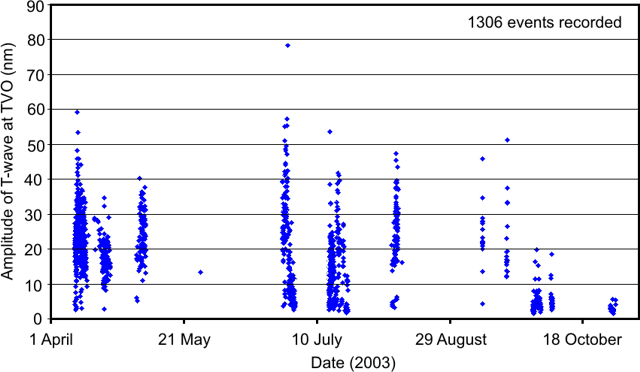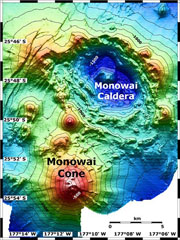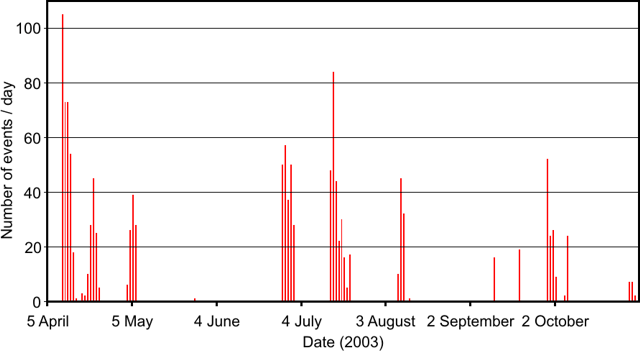Report on Monowai (New Zealand) — November 2003
Bulletin of the Global Volcanism Network, vol. 28, no. 11 (November 2003)
Managing Editor: Edward Venzke.
Monowai (New Zealand) Eleven earthquake and T-wave swarms during April-November
Please cite this report as:
Global Volcanism Program, 2003. Report on Monowai (New Zealand) (Venzke, E., ed.). Bulletin of the Global Volcanism Network, 28:11. Smithsonian Institution. https://doi.org/10.5479/si.GVP.BGVN200311-242050
Monowai
New Zealand
25.887°S, 177.188°W; summit elev. -132 m
All times are local (unless otherwise noted)
Monowai is a frequently active submarine volcano that has had volcanic earthquake swarms recorded in May 2002 (BGVN 27:05), November 2002 (BGVN 28:02), and April-May 2003 (BGVN 28:05). Monowai exhibited increased activity for the first 11 months of 2003, during which more than 1,300 events were detected and located by the French Polynesian seismic network via hydro-acoustic waves (also called T-waves) generated by this submarine volcano. Each volcanic eruption, creating explosions and boiling water, generates hydro-acoustic waves that are able to propagate several thousands of kilometers through the ocean in a wave guide (a low velocity zone located at ~1,000 m depth called the SOFAR—Sound Fixing and Ranging—channel). Consequently, a major part of the volcanic activity can be monitored at great distances in the oceans (> 3,000 km) using the T-waves. The amplitudes of T-waves correlate with the strength or intensity of the eruptions.
Activity at Monowai during 2003 has been much greater than in 2002. From April through November 2003, 11 swarms have been detected (figure 14); about one swarm was detected every two weeks except in the months of June and September, when no T-waves were detected from Monowai. A volcanic swarm started suddenly on 10 April 2003 with an average rate of about 50-60 events per day (figure 15). The activity seemed to decrease smoothly in 2003 compared to abrupt halts in activity in 2002.
 |
Figure 14. Amplitudes of T-waves from Monowai recorded at the TVO station on Tahiti during 1 April through early November 2003. Courtesy of Laboratoire de Geophysique, Tahiti. |
The observed swarms are composed of a lot of events over at least 30 minutes containing many tens of signals, producing a quasi-continuous and fluctuating noise. However, these types of signals are detected across the entire seismic network. If a particular wave (a maximum amplitude, or the beginning of a wave) visible in all the seismic records is selected, it is possible to locate the source by the inversion of the travel time. Sometimes strong amplitudes are recorded that can be correlated with the strength of the volcanic explosion.
Geological Summary. Monowai, also known as Orion seamount, is a basaltic stratovolcano that rises from a depth of about 1,500 to within 100 m of the ocean surface about halfway between the Kermadec and Tonga island groups, at the southern end of the Tonga Ridge. Small cones occur on the N and W flanks, and an 8.5 x 11 km submarine caldera with a depth of more than 1,500 m lies to the NNE. Numerous eruptions have been identified using submarine acoustic signals since it was first recognized as a volcano in 1977. A shoal that had been reported in 1944 may have been a pumice raft or water disturbance due to degassing. Surface observations have included water discoloration, vigorous gas bubbling, and areas of upwelling water, sometimes accompanied by rumbling noises. It was named for one of the New Zealand Navy bathymetric survey ships that documented its morphology.
Information Contacts: Dominique Reymond and Olivier Hyvernaud, Laboratoire de Geophysique, CEA/DASE/LDG Tahiti, P.O. Box 640, Papeete, French Polynesia.


